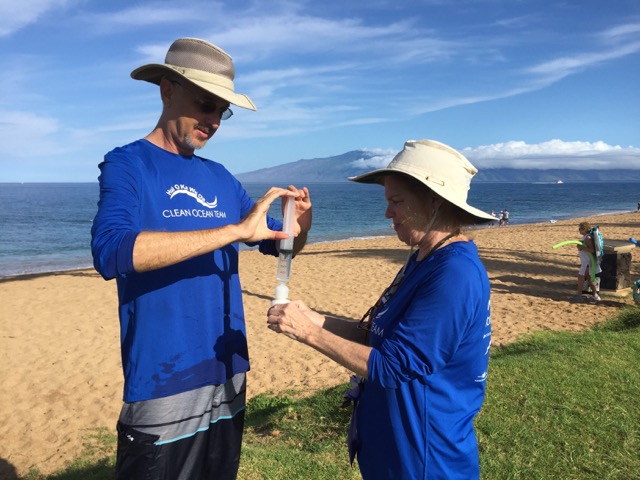New Science Agreement to Improve Maui Coastal Water Quality

Citizen-science volunteers Ty Freiberg (left) and Marie Schroeder (right) collect water quality samples on Maui as part of the island’s newly launched Hui O Ka Wai Ola water quality monitoring program.
Coastal water quality on Maui is getting a boost from a Quality Assurance Project Plan developed by The Nature Conservancy, Maui Nui Marine Resource Council and Department of Health scientists.
Project leaders say the plan will augment the efforts of the single DOH employee responsible for all water quality monitoring across the entire island of Maui.
“Coastal water quality is directly affected by actions on land,” said Dr. Kim Falinski, the Conservancy’s marine science advisor, who, along with Dana Reed, Chair of MNMRC’s Clean Water Committee, collaborated with the DOH to develop the plan.
“Regular, long-term water quality monitoring can provide the information needed to guide land management efforts to protect coral reefs, local fisheries, and coastal communities from the effects of land-based pollution,” Falinski said.
To build capacity for collecting water samples, the Conservancy, the MNMRC, the West Maui Ridge to Reef Initiative and the University of Hawaii joined forces to launch Hui O Ka Wai Ola, a citizen science program that helped develop the QAPP. Project leaders say that following the QAPP’s strict monitoring methods will allow data gatherer by Hui O Ka Wai Ola volunteers to be integrated with other data collected by DOH to determine where Maui’s coastal waters are impaired, so that efforts can be mobilized to make the needed changes for improvement.
“Hui O Ka Wai Ola helps us by providing more samples on Maui that we can use to assess changes in water quality,” said Watson Okubo, Monitoring and Analysis Section Chief, Clean Water Branch, State Department of Health. “It’s a good idea to build up our community’s expertise and understanding of water quality issues, and having access to trained community members who can accurately assess water quality could help extend our capacity in case of an emergency,” he said.
Scientists from the Conservancy and the MNMRC worked closely with DOH to expand beyond sampling for the bacteria Enterococcus, a fecal pathogen indicator, to sampling for nutrients such as nitrogen and phosphorous which can damage coral reefs and habitat for fish. Using the methods outlined in the QAPP, volunteers of Hui O Ka Wai Ola can also collect data on ocean salinity, pH (acidity), temperature, organic nutrients such as nitrogen and phosphorous, and dissolved oxygen. They can also assess the total amount of sediment suspended in the water, which is especially helpful after large rain storms.
“Unfortunately, brown water events have become all too common on Maui – we see some of our coastal waters filled with sediment after each storm,” said Emily Fielding, the Conservancy’s Maui Marine Program Director.
“Across Maui Nui we are experiencing some of the worst water quality in the state, which impacts our coral reefs and fisheries, and all the benefits we derive from them – for food, recreation, and the economy. Poor water quality, combined with coral bleaching from climate change, can push our reefs beyond their capacity to recover,” said Fielding.
The DOH’s Draft 2016 State of Hawaiʻi Water Quality Monitoring and Assessment Report shows that from the 2013- 2015, just two coastal watersheds on Maui had enough water quality data to perform assessments. Within those two watersheds, 75% (six of eight) of the nutrient assessments did not meet the nutrient water quality criteria.
A recent UH study showed that coral cover on Maui’s northern reefs declined from 30% to 10% between 2000 and 2015; one likely cause is sediment and pollutant runoff during large rain storms. Sediment and nutrients can be indicators of sewage pollution, or of agricultural, residential, golf course and landscaping run-off. They can also indicate overgrazing and soil disturbance from feral hooved animals such as deer, pigs, and cattle, or where streams and gulches are eroded. Once in the ocean, these nutrients can lead to rapid algal overgrowth that can compete with coral reefs. Sediment can also smother and kill coral reefs, which are important habitat for our nearshore fisheries.
“Our goal with Hui O Ka Wai Ola is to supplement DOH water quality monitoring and, in doing so, create a more complete picture of the status of Maui’s nearshore waters,” said Dana Reed, who is Hui O Ka Wai Ola’s Volunteer Team Leader as well as a scientist with MNMRC.
Currently the group is focused on 18 sites in West Maui from the Papalaua Pali to Nāpili Bay. “We’re excited to be able to take steps that will help us understand and address Maui’s brown water events and other water impairment problems.” Reed said.
Robin Newbold, Chair of the MNMRC, expressed her gratitude for the generous support of this project from the following corporate sponsors: North Beach West Maui Benefit Fund, Maui County Office of Economic Development, Pride of Maui, Maui Ocean Center, Hawaiian Paddle Sports, Nāpili Bay and Beach Foundation, and Marisla Fund — along with that of many individual donors and devoted volunteers.
Interested in volunteering? Visit www.huiokawaiola.com to learn how to get involved.










